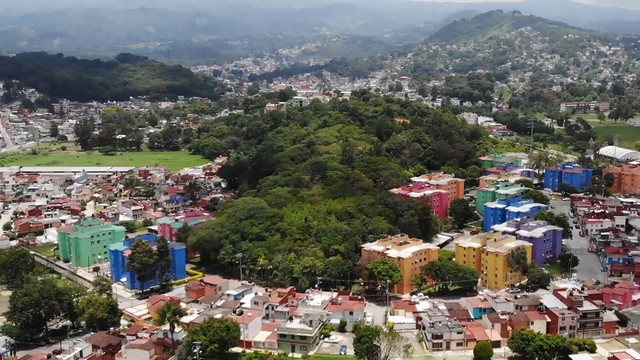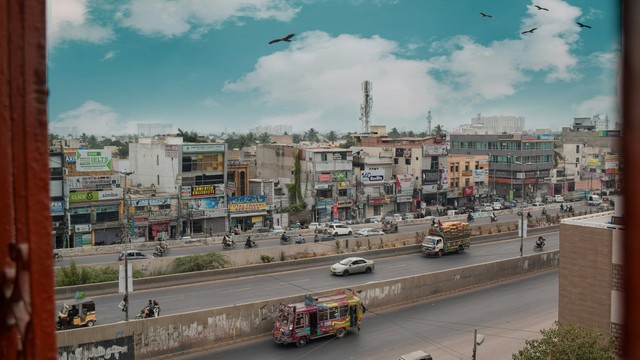Let's see what the BRICS teach us about urbanisation and economic growth
Our new interactive data visualisation plots countries' incomes per capita against their levels of urbanisation.


Our new interactive visualisation plots countries’ incomes per capita against their levels of urbanisation.
Governments tend to love economic growth, and be very ambivalent about urbanisation. Yet countries don't become wealthy without urbanising. Moreover, efforts to inhibit urbanisation have often been socially destructive. What can the BRICS (Brazil, Russia, India, China and South Africa), the economic darlings of the early 2000s, tell us about transcending this policy conundrum?
We have followed up a recent book on the subject with an interactive visualisation on urbanisation and economic change. We worked with experts at Kiln to create this visualisation, which involves a simple graph that can be moved from 1980 to 2010, plotting countries' incomes per capita against their levels of urbanisation. This simple device demonstrates some striking characteristics of the dynamics of urbanisation and economic change, some of which are illustrated with reference to the BRICS in an introductory video. We recommend you play the video on your first visit.
I decided to work with Kiln on this visualisation in the hope that it would provide a device for conveying some of what I thought I knew about urbanisation to others less familiar with the topic. The eye-opener was how much I learned in the process. And as I said to a colleague, many of these patterns are obviously very significant statistically – though I don't yet know how to prove it.
We put an only somewhat tongue-in-cheek warning at the end of the visualisation – Use this information with care: excessive economic growth can be hazardous to your planet's health.
After all, a narrow minded prioritisation of economic competition and growth can be environmentally as well as socially disastrous. Still, it is critically important to gain a better understanding of how and why urbanisation can contribute to economic productivity, and what can be done to enhance this contribution and put it to good use.
Examples of urban growth in the visualisation
Cities as engines of economic growth in China
The most powerful image is perhaps that of China, its GDP-scaled ball picked out in red, racing across income-urbanisation space, cutting right across the middle of the distribution of other countries and growing to become one of the largest economies of the world by 2010.
Even if you are familiar with the numbers, this visualisation is compelling. The press typically ascribes China's economic leap to liberalisation, which began in late 1970s. But China has also been one of the few countries to encourage urbanisation, and to use cities as hotbeds of experimentation and incremental change, aimed at transforming cities into engines of economic growth.
They succeeded, albeit at a cost. The transformation of China's cities and its economy are not two stories, but one. (This story is elaborated in the book, along with those given below for the other BRICS.)
A less successful story in Russia
Anyone who thinks that China's success was simply the result of setting markets free should watch the Russian ball bounce. After Russia's liberalisation, its red ball threatens to sink into an economic pit, only beginning to bounce back in the late 1990s.
Of course, Russia was starting out far more urban, unable to use urbanisation as a tool of economic transformation, and it underwent wrenching political and social shocks. It was also very different in a host of other ways, including the uneconomic locations of many of its cities.
Reluctant urbanisation in India
India's red ball does better at emulating China's economic success, though it has tried to avoid rapid urbanisation, and perhaps partly as a result has also avoided such rapid economic growth. Also, the inhibited urbanisation probably doesn't bode well for those who might otherwise have found a more secure place in India's cities.
A bumpy road in South Africa
South Africa has suffered socially as well as economically from its past racist anti-urbanisation policy – apartheid. Thus it is not surprising that the South African ball experienced a bumpy road, and that South Africa is still searching for ways of transforming its cities from their still overly fragmented forms.
Ups and downs in Brazil
Over the same 1980-2010 period, the Brazilian ball bounces along in a more urban but not much wealthier direction, only rising near the end.
Brazil has had a history of passive resistance to urbanisation and urban population growth. Overt attempts to curb the rapid growth of cities failed, but the predictable growth in low income urban population was not planned for, in part so as not to encourage rural-urban migration.
Brazil's favelas (low-income unplanned settlements) and related inequalities have been a legacy of this. On the other hand, recent decades have seen important urban experimentation in participatory budgeting, conditional cash transfers and other measures that have begun to shift Brazil down from its heights of inequality – perhaps in a later visualisation we will try to add in the inequality dimension.
Deciphering regional signatures
These patterns show the BRICS displaying very different dynamics from each other, which has implications for their economic, social and even environmental prospects. What the visualisation also shows, and which is far harder to convey convincingly in words or even statistics, is that most of the BRICS are following paths whose signatures are characteristic of their regions.
The close positive relationship between urbanisation and economic growth exhibited by the Chinese and Indian signatures is emulated in other Asian countries. The fall and rise of the Russian signature, with little shift in urbanisation, is characteristic of the other post-Soviet states. Brazil's bouncy signature is Latin American. The African region exhibits too much diversity to have a characteristic signature, but South Africa does at least conform in the weak sense that it doesn't stand out.
This visualisation is the second of two recent cities-focused data visuals from IIED's Human Settlements Group. The previous one illustrated the scale and speed of urban transformation.
Take a look at the visualisation and share your findings with us!
Related publication:
Urban Growth in Emerging Economies: Lessons from the BRICS, Edited by Gordon McGranahan and George Martine (2014), Routledge



